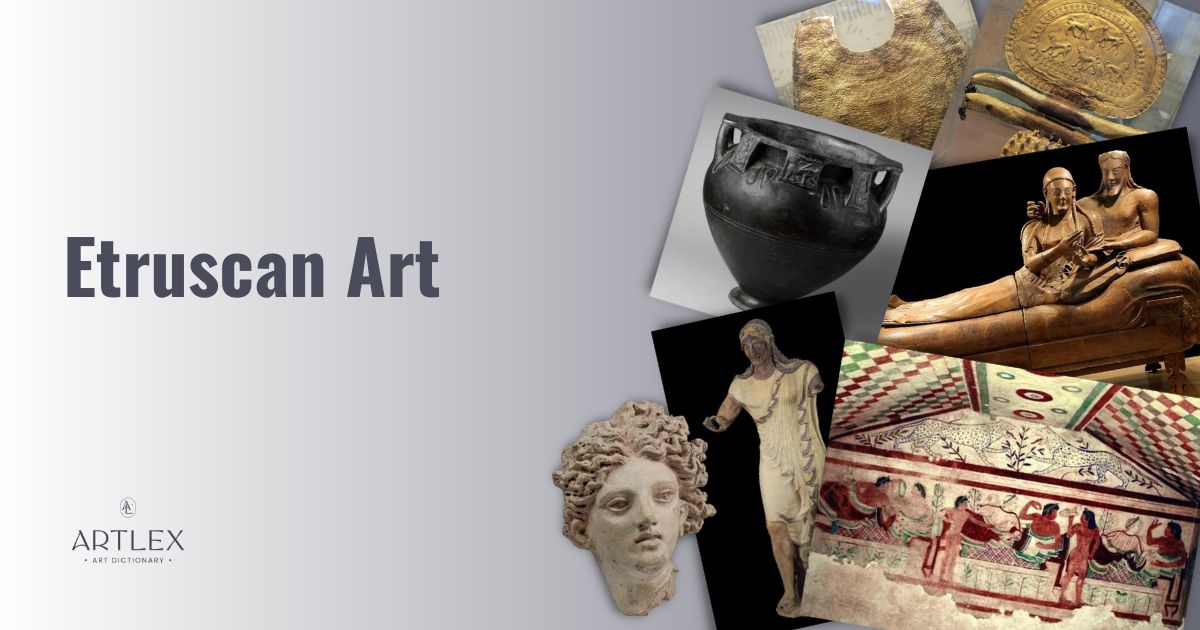 What is Etruscan Art?
What is Etruscan Art?
Etruscan art refers to the ancient Mediterranean art of the Etruscan people, who lived in what is now Italy, between the 10th century BCE-270 CE, prior to the Romans. Most of the art that remains from the Etruscan civilization comes from elaborate burials and includes tomb paintings, sculpture, and pottery.
Famous Etruscan Artwork
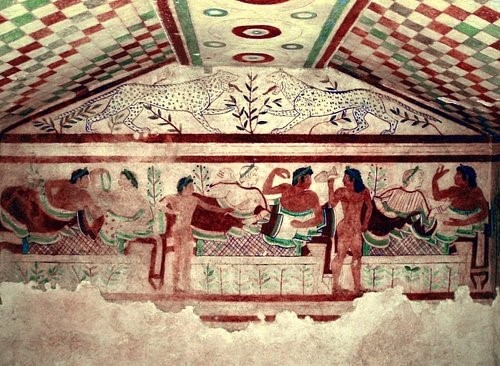
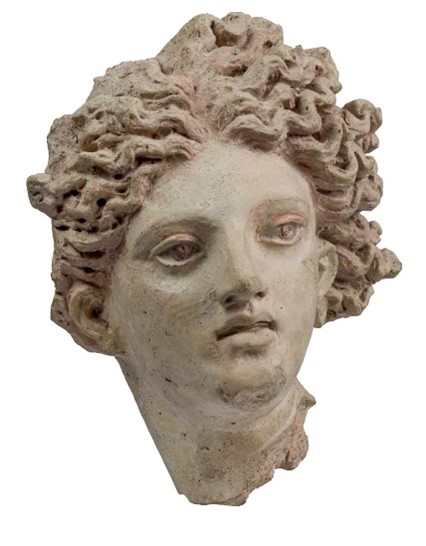
ETRU National Etruscan Museum (museoetru.it)
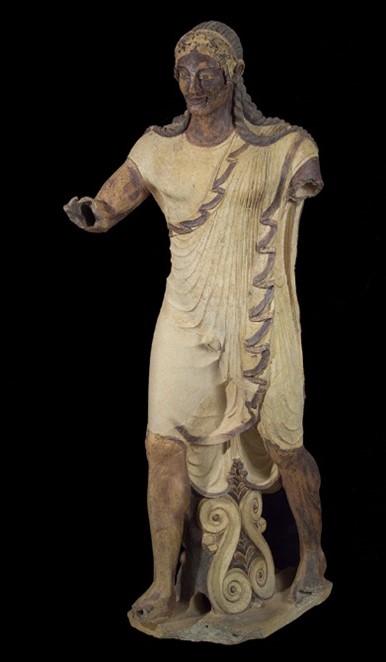
ETRU National Etruscan Museum (museoetru.it)
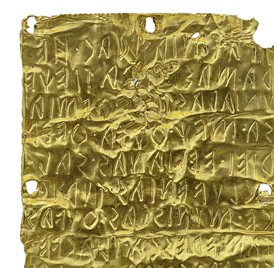
ETRU National Etruscan Museum (museoetru.it)
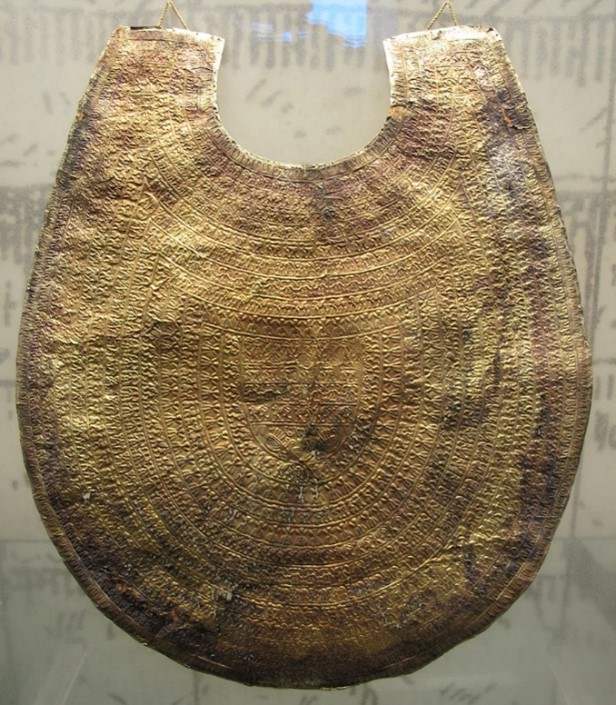
Gold pectoral (museivaticani.va)
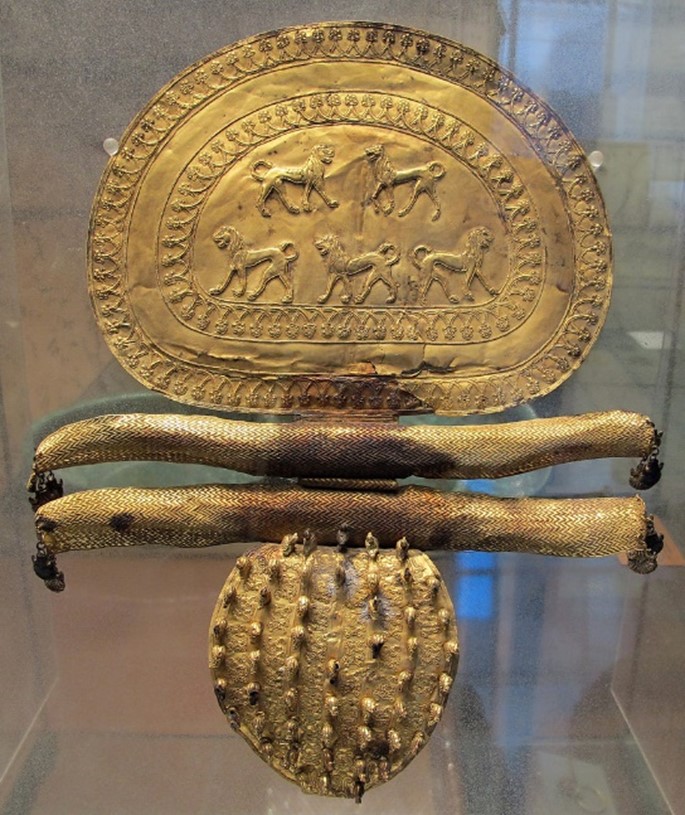
Large parade Fibula (museivaticani.va)
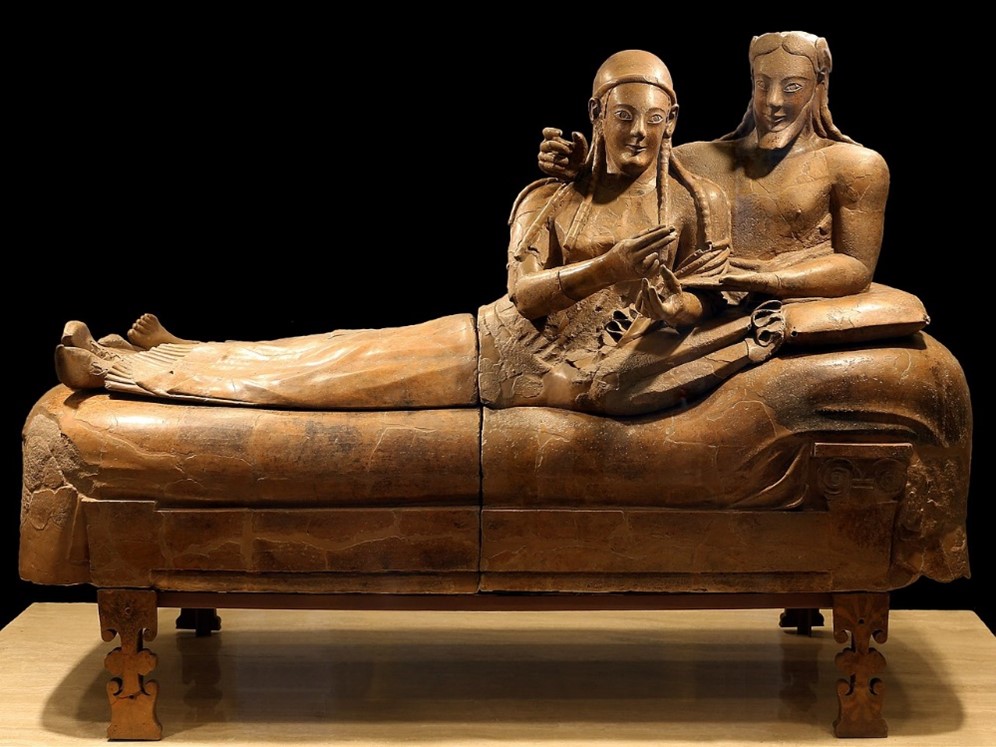
ETRU National Etruscan Museum (museoetru.it)
Historical Context of the Etruscan People
The Etruscans lived in a collection of cities in the area now known as Tuscany. Etruscan cities included Florence, Pisa, and Siena. The most important city was Traquinia, located 90 kilometers from Rome. According to Etruscan legend, the city of Traquinia was started by Tarchon, the son of Tyrrehun, the king of the Tyrrhenian Sea, and grandson of Hercules.
Etruscans earned a living as traders of natural minerals, most notably copper and bronze, and conducted business with the Greeks, Phoenicians, and Egyptians. Etruscans also made a living as seafarers.
Developments of the Etruscan people include gladiator combat, the design of Etruscan temples and rituals for religion. These things were absorbed into Roman art and culture.
Etruscans were great fans of Greek art and incorporated these ideas into Etruscan artworks.
Characteristics of Etruscan Art
Etruscan artists excelled at creating works in terracotta, from table wares to stand alone sculptures. Influenced by the Greek art communities residing the southern Italy, sculptural works contain rounded faces, stylized hair, and archaic smiles.
Fresco paintings were found in tombs. Through the visuals of Etruscan painting art historians were able to learn more about life in Etruscan civilization.
The Etruscan artists were skilled metal workers and incorporated bronze, silver, iron, copper, and tin into their works. During the Archaic and Classical (490–300 BCE) Periods, Etruscans were master bronzesmiths, exporting their works, from chariots to decorative arts. Jewelry creations were the result of travel and trade and made use of gold, semi-precious stones, amber and ivory.
Etruscan art funerary works include sarcophagi and cinerary urns.
Characteristics of Etruscan Architecture
Homes and temples were not made of stone, but of terra cotta, wood, and mudbricks. Etruscans were the first to incorporate Tuscan columns , cellas, arched gates and pediments and were well known for architectural reliefs. Private villas with atriums were designed by Etruscan architects, as were large temples on raised platforms. Due to construction materials and wars, very little architecture survives from Tuscan civilization.
Etruscan Funerals as Celebrations
Sophisticated necropolis with rock wall tombs attests to the Etruscans interest in the afterlife. Housing their dead in comfort, interiors were as welcoming as homes, with a variety of objects to assist in the transition. Items included everything from tables wares to gold jewelry.
Funerals were joyous affairs with banquets, dancing and music as depicted in frescoes and other Etruscan art surrounding these events.
Paintings and More: Inside Etruscan Tombs
Paintings in Etruscan tombs have helped historians piece together what life was like for the Etruscan civilization.
Paints were made from organic materials such as white from chalk or kailin, green from malachite and red and yellow from iron oxide. Black came from a variety of vegetable materials, while blue was rare and likely imported.
Early Etruscan tomb paintings date to the mid-6th century BCE. Around this time the Campana Tomb at Veii, in the rock of the Poggio Michele hills, was cut into a wide passage. Two lion sculptures flank either side of the entrance, as if to guard the dead.
Examples of early Etruscan tomb painting appear on the walls. Here there are four frescoes with people, horses, and creatures from legends.
Two skeletons of a man and woman were found at the entrance. Four large vases contained human ashes. The tomb held furniture, while décor included small sculptures.
Frescoes and The Tombs of Tarquinia
The Tombs of Tarquinia, is the largest pre-Roman tomb in existence. The necropolis in Tarquinia, Italy, has 6000 tombs, 200 of which are painted. Built from local tufa, the subterranean rock cut tomes housed the remains of people, along with grave goods.
The subject of many of the frescoes is the funeral banquet scene with people reclining on dining couches. There is feasting, music and dancing. Some tombs are painted with interior elements to represent architecture in the form of windows, doors, and columns.
Examples of the tombs inside include the Tombs of the Bull (540-530 BCE) made from Aranth Spurianas, as confirmed by the name painted on the wall. The walls included scenes from mythology, couples intwined, both heterosexual and homosexual, as well as two bulls. A young man rides a mythical seahorse called a hippocamp into the afterlife.
Tomb of the Lionesses (530-520 BCE) does not depict lionesses, but panthers, a party scene and a checkered ceiling that resembles the roof of a tent.
Etruscan Art of Ceramics
Etruscans made works using impasto or unrefined red clay that would fire to black. This was used to make basic pottery for cooking and storage.
Bucchero, a black burnished pottery was distinct to Etruscan art and used by the elite during banquets. To obtain the dark color pieces were fired in a process restricting the oxygen in the kiln. This caused the iron oxide in the clay to darken. The result were objects with a metallic luster.
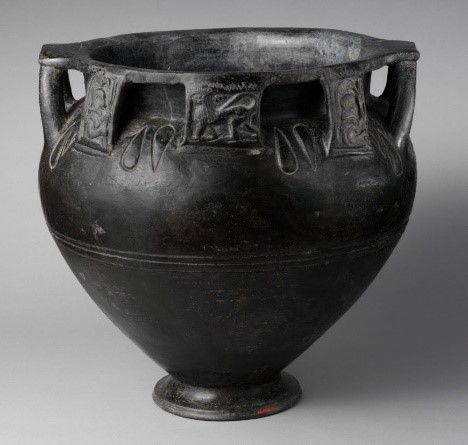
Etruscan Vase Painting
Terracotta amphora with lid, now housed at the Metropolitan Museum of Art, in New York, dates to the 3rd quarter of the 6th century BCE. This ancient vessel used for storage has a classic Greek shape with two handles, a lid and echinus foot. The black-figure technique in painting the mythological creatures and animals is also influenced by Greek art, although the subject matter is Etruscan.
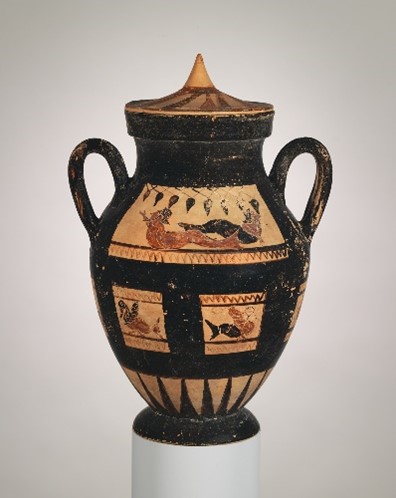
Etruscan Sculpture
While smaller Etruscan sculpture works were made with bronze, larger works were made from terra cotta. Head of Leucotea (470-460 BCE) is a female head made from painted terra cotta. It was once part of a large relief that decorated Temple A, in the ancient port of Caere. The name means “white goddess” and represents the Greek goddess, who was known as Ino as a mortal woman.
Etruscan Art in Metalworks
The three Pyrgi Tablets (500 BCE), made from gold, are inscribed with text. Two contain the Etruscan language and one Phoenician, both of which no longer spoken. Though the texts are brief, the Pyrgi Tablets dating to the 6th century do provide valuable insight.
Gold Discovery at the Regolini-Galassi Tomb
The discovery of the Etruscan tombs of a high-ranking woman of Etruscan civilization, in 1836, by archaeologists Archbishop Alessandro Regolini and General Vincenzo Galassi, unearthed the largest collection of gold ever found. Located in Cerveteri, 50 kilometers from Rome, the Regolini-Galssi Tomb was built between 680-660 BCE.
Two people were buried here. The first was a wealthy woman, named Larthai, buried with her personal collection of jewelry, and a man who was cremated.
Inside the tomb was a wealth of gold jewelry. A large gold pectoral or necklace measuring 19 inches wide, is embossed with plants and animals. The external strip was comprised of triangles or “wolves’ teeth. There are lions with lotuses in their mouths, along with an ibex and deer. More fantastical creatures include a gryphon, a Pegasus, and winged women.
There was also a belt and a huge fibula of gold, decorated in Eastern style, with five lions in the center and decorative floral motifs on the edges. Two wide gold bracelets found have panels containing three female figures, and others with lions.
There were also additional earrings, rings, pins, and necklaces made of gold. Bowls crafted from bronze and silver found and interestingly, a bronze bed/carriage. With four wheels, the bed has illustrations of thirty-three figures all in mourning.
These items show the skill of metalwork in Etruscan art.
Etruscan Art: Funerary Works
When Etruscans died, they were cremated, and the remains were placed in a hut urn. These were made with impasto or unrefined clay as was typical of Iron Age Etruria (900-750 BCE)
During the Orientalizing period (750-575 BCE) the Etruscans became a wealthy society. During and after this time, tombs became more lavish. Sarcophagus of the Spouses from 520 BCE at Museo Nazionale di Villa Giulia, in Rome, is an example of a terra cotta work made to place the cremated human remains of a couple. The couple are depicted taking part in their own funerary feast, reclining on a feasting couch, eating, and drinking.
While the faces reflect the common Greek art style, the elongated bodies and Etruscan in nature. The woman wears an Etruscan headdress known as a tutulus. Her Eastern inspired shoes called calcei repandi have toes that bend upward.
Etruscan Temples
Mudbrick and wood were the construction materials used to build Temple of Minerva, in Veii, near Rome, Italy. It no longer survives today, yet the description was recorded in the book De architectura, by Vitruvius. The 50 by 70-foot building was set upon a raised platform, with stairs leading to the front. The Tuscan columns were once painted in bright colors. At the back were three cellas dedicated to Minerva (Athena), Zeus (Jupiter) and Hera (Juno). Cellas were an invention of Etruscan temples.
On top of the temple sat acroteria or roof sculptures of which several examples survive. The most famous is the sculpture of Apollo of Vei, standing a life-sized 5 feet 11 inches, in Museo Nazionale di Villa Giulia, in Rome.
Related Art Terms
- Terra cotta
- Tuscan columns
- Cellas
- Arched gates
- Pediments
- Architectural reliefs
- Raised platforms
- Necropolis
- Fibula
- Amphora
- Bucchero
- Column-krater
- Sarcophagus
- Echinus foot
- Black-figure technique
- Frescoes
- Acroteria
